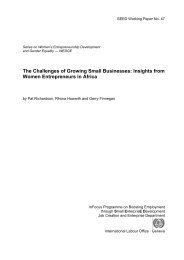Elimination of Child Labour in Commercial Agriculture project (
Elimination of Child Labour in Commercial Agriculture project (
Elimination of Child Labour in Commercial Agriculture project (
You also want an ePaper? Increase the reach of your titles
YUMPU automatically turns print PDFs into web optimized ePapers that Google loves.
<strong>Elim<strong>in</strong>ation</strong> <strong>of</strong> <strong>Child</strong> <strong>Labour</strong> <strong>in</strong> <strong>Commercial</strong> <strong>Agriculture</strong> <strong>project</strong><br />
(COMAGRI)<br />
The <strong>project</strong> was a sub-regional <strong>project</strong> implemented <strong>in</strong> five countries: Kenya,<br />
Malawi, Tanzania, and Uganda Zambia. The <strong>project</strong> started <strong>in</strong> 2001. COMAGRI<br />
aimed to withdraw children from hazardous work <strong>in</strong> commercial agriculture and<br />
prevent them be<strong>in</strong>g trapped <strong>in</strong> these situations. The Programme raises<br />
awareness at all levels <strong>of</strong> government and civil society about the dangers <strong>of</strong> child<br />
labour and strengthens their capacity to deal with it.<br />
Programme Development Objective: To contribute to the elim<strong>in</strong>ation <strong>of</strong> worst<br />
forms <strong>of</strong> child labour <strong>in</strong> commercial agriculture <strong>in</strong> Tanzania<br />
Immediate Objectives By the end <strong>of</strong> the <strong>project</strong>, the capacity <strong>of</strong> governmental,<br />
non-governmental, community, employers’ and workers’ organizations will be<br />
strengthened, to identify and elim<strong>in</strong>ate hazardous child labour <strong>in</strong> farms and<br />
plantations,: 1,200 children work<strong>in</strong>g under hazardous conditions <strong>in</strong> selected<br />
plantations <strong>in</strong> five countries will have been withdrawn and rehabilitated and their<br />
families provided with viable alternatives to exploitative child labour; A further<br />
2,000 at-risk children prevented from prematurely enter<strong>in</strong>g the labour market.<br />
Programme Strategy A strong focus on the prevention <strong>of</strong> child labour. Targeted<br />
action to combat hazardous and exploitative child labour <strong>in</strong> selected farms and<br />
plantations. On the basis <strong>of</strong> rapid assessments on worst forms <strong>of</strong> child labour <strong>in</strong><br />
the tobacco sector (done <strong>in</strong> 2000/2001), a basel<strong>in</strong>e study on hazardous child<br />
labour <strong>in</strong> the tea sector (done <strong>in</strong> 2002), situation assessment <strong>of</strong> hazardous child<br />
labour <strong>in</strong> tobacco farm<strong>in</strong>g (done <strong>in</strong> 2003) and conducted <strong>in</strong> the four <strong>project</strong><br />
districts, <strong>project</strong> sites with a high <strong>in</strong>cidence <strong>of</strong> hazardous child labour were<br />
selected for participation <strong>in</strong> the programme. The specific hazards faced by child<br />
workers <strong>in</strong> the tea and tobacco vary considerably <strong>in</strong> farms and plantations,<br />
depend<strong>in</strong>g on the crop, the size <strong>of</strong> the farm/plantation, and the level <strong>of</strong> awareness<br />
and action among the concerned partners, especially the employers and<br />
managers. Particular attention is given to children who are specially at risk (i.e.<br />
those under the age <strong>of</strong> 12 years and the girl child). In addition to the 1,200<br />
children targeted <strong>in</strong> this programme, about 2,000 other children are benefit<strong>in</strong>g<br />
from awareness rais<strong>in</strong>g programmes; monitor<strong>in</strong>g mechanisms at the community<br />
level, development <strong>of</strong> strategies to be <strong>in</strong>corporated <strong>in</strong> the <strong>Child</strong>ren Development<br />
Policy changes as well as from changes <strong>in</strong> society’s attitudes towards the<br />
exploitation <strong>of</strong> children <strong>in</strong> hazardous work.<br />
Families weighed down by poverty are provided with tra<strong>in</strong><strong>in</strong>g, <strong>in</strong>formation sav<strong>in</strong>gs<br />
and credit facilities, on how to start and manage <strong>in</strong>come generat<strong>in</strong>g activities; and<br />
provided with grants to start small <strong>in</strong>come-generat<strong>in</strong>g <strong>project</strong>s. The <strong>project</strong> also<br />
strives to educate and conv<strong>in</strong>ce parents that education for their children will yield<br />
long term benefits.
In order to have a larger impact, the <strong>project</strong> strives to l<strong>in</strong>k up with other<br />
development programmes active <strong>in</strong> the target areas, support Government to play<br />
a central role, and encourage employers to provide much-needed local <strong>in</strong>put.<br />
COMAGRI therefore is act<strong>in</strong>g as a catalyst for change and it is expected that<br />
<strong>project</strong> results will attract more commitment from communities, government and<br />
other stakeholders to fight aga<strong>in</strong>st the worst forms <strong>of</strong> child labour <strong>in</strong> commercial<br />
agriculture.<br />
Strong community <strong>in</strong>volvement, awareness rais<strong>in</strong>g and the withdrawal <strong>of</strong> child<br />
workers. A step-by-step removal and community-based monitor<strong>in</strong>g <strong>of</strong> children <strong>in</strong><br />
exploitative and hazardous work is carried out through the <strong>Child</strong> <strong>Labour</strong><br />
Monitor<strong>in</strong>g System. Community <strong>Child</strong> <strong>Labour</strong> Committees (CCLCs) have been<br />
set up <strong>in</strong> communities. Members <strong>of</strong> the committees <strong>in</strong>clude representatives <strong>of</strong><br />
employers and/or managers <strong>of</strong> estates/plantations/commercial farms, trade<br />
unions, parents <strong>of</strong> work<strong>in</strong>g children, local government <strong>of</strong>ficials, health workers,<br />
teachers, and other <strong>in</strong>fluential community members. Balanced gender<br />
representation is encouraged to ensure the needs <strong>of</strong> mothers and the girl child<br />
are adequately represented. Where possible, designated labour <strong>in</strong>spectors do<br />
participate <strong>in</strong> the CCLCs.<br />
The rehabilitation <strong>of</strong> 1,200 child workers <strong>in</strong> selected farms and plantations follows<br />
a three-pronged strategy and all the <strong>in</strong>terventions for child workers and their<br />
families is implemented through partner agencies identified by IPEC/COMAGRI.<br />
1. For work<strong>in</strong>g girls and boys below 12 years the packages <strong>of</strong> alternatives<br />
have a non-formal education component (i.e. COBET classes where<br />
children are tra<strong>in</strong>ed <strong>in</strong> basic literacy and numeracy skills) and formal<br />
school education.<br />
2. For older work<strong>in</strong>g girls and boys <strong>in</strong> the age group <strong>of</strong> 12-14 years, the<br />
strategy focus skills tra<strong>in</strong><strong>in</strong>g that would lead them on to ga<strong>in</strong>ful<br />
employment as young adults. Efforts are made to discuss with vocational<br />
skills tra<strong>in</strong>ers to prepare tailor made programmes for these children.<br />
For older work<strong>in</strong>g adolescents between the ages <strong>of</strong> 15 and 18 years, the strategy<br />
provides them with vocational tra<strong>in</strong><strong>in</strong>g, accord<strong>in</strong>g to their gender needs. This is<br />
based on the assumption that many <strong>in</strong> this age group prefer to learn a skill or<br />
trade that would guarantee them employment.<br />
COMAGRI also l<strong>in</strong>k micro-credit facilities exist<strong>in</strong>g <strong>in</strong> the <strong>project</strong> areas to<br />
alternatives provided to families so that the <strong>in</strong>come status <strong>of</strong> the household is<br />
improved and younger sibl<strong>in</strong>gs are prevented from enter<strong>in</strong>g the labour market<br />
prematurely. When children are withdrawn from hazardous work, it is be crucial to<br />
look at the impact <strong>of</strong> withdrawal on the economic survival <strong>of</strong> the family. Family<br />
<strong>in</strong>come is therefore supplemented by provid<strong>in</strong>g families with <strong>in</strong>come generat<strong>in</strong>g<br />
opportunities to replace the loss <strong>of</strong> <strong>in</strong>come.<br />
Employers’ organisations represent<strong>in</strong>g the commercial agricultural sector have<br />
an important role to play and are responsible for a wide range <strong>of</strong> activities from
awareness-rais<strong>in</strong>g to participat<strong>in</strong>g <strong>in</strong> CCLC meet<strong>in</strong>gs. Estate/plantation owners<br />
are also encouraged to contribute to the cost <strong>of</strong> social services <strong>in</strong> and around<br />
plantations to show their commitment to the success <strong>of</strong> the <strong>project</strong>.<br />
Rais<strong>in</strong>g the awareness <strong>of</strong> adult workers is critical. <strong>Child</strong>ren usually work<br />
alongside adults; <strong>of</strong>ten their parents. Such adult workers are <strong>in</strong> the best position<br />
to provide guidance to the children and to barga<strong>in</strong> collectively with employers to<br />
ensure child labour is not used. Workers' organisations active <strong>in</strong> the commercial<br />
agriculture e.g. the Tanzania Plantation and Agricultural Workers Union<br />
(TPAWU) have played a key role <strong>in</strong> a wide range <strong>of</strong> activities rang<strong>in</strong>g from<br />
awareness-rais<strong>in</strong>g, withdrawal and rehabilitation <strong>of</strong> children to monitor<strong>in</strong>g<br />
collective barga<strong>in</strong><strong>in</strong>g arrangements at the workplace level.<br />
Institutional Framework: The M<strong>in</strong>istry <strong>of</strong> <strong>Labour</strong> is the primary organ responsible<br />
for carry<strong>in</strong>g out regular <strong>in</strong>spection visits and for provid<strong>in</strong>g advisory services to<br />
employers. Employers' Organisations, Workers' Organisations, M<strong>in</strong>istry <strong>of</strong><br />
Education, M<strong>in</strong>istry <strong>of</strong> Healt,h Local Government Authorities, Non-Governmental<br />
Organisations and Community-based Organisations<br />
Community Level: he CCLCs are the central unit at the community level. The<br />
committees are kept <strong>in</strong>formed <strong>of</strong> progress with programme implementation and <strong>in</strong><br />
turn, provide <strong>in</strong>formation to the social partners, labour <strong>in</strong>spectors, and district<br />
child labour coord<strong>in</strong>ator, on issues <strong>of</strong> concern at the community level.<br />
National Level: The National Inter-sectoral Coord<strong>in</strong>ation Committee is oversee<strong>in</strong>g<br />
COMAGRI programme progress through its Technical Sub-Committee and the<br />
Sub-Committee on <strong>Child</strong> <strong>Labour</strong> <strong>in</strong> M<strong>in</strong><strong>in</strong>g and <strong>Agriculture</strong>.<br />
Districts covered: Lushoto, Korogwe, Muheza and Urambo, target<strong>in</strong>g children<br />
work<strong>in</strong>g <strong>in</strong> tea farms and plantations (<strong>in</strong> the first three districts); and target<strong>in</strong>g<br />
children work<strong>in</strong>g on tobacco farms <strong>in</strong> Urambo district.

















